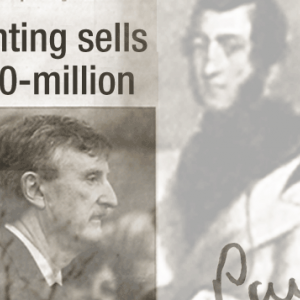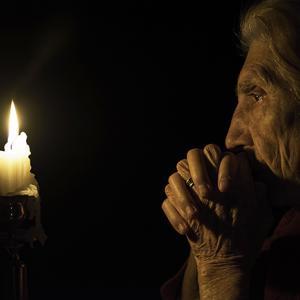"The Art of Salesmanship"
By Andrew Mills
Toronto Star
Nov 28, 2004
By the time lot 12 came up at Heffel's art auction Thursday night, David Loch had moved his chair to the middle of the aisle for an uninterrupted view of the auctioneer.
Bidding on the large winter scene by William Kurelek opened at $40,000 and, though the action was at the front of the hotel ballroom, the auctioneer's gaze rarely strayed from Loch, who was refusing to bid, some 20 rows away.
Unflinching, Loch stared back, his cellphone pressed hard to his right ear. "85 up front. 90. 95. Okay," Loch calmly told the client on the other end of the phone, lifting his paddle no higher than his head to bid $100,000. "We're in now."
Almost immediately, the bidder up front advanced to $110,000. Loch raised his paddle again. $120,000.
"130 up front," said the auctioneer. Loch was back again at $140,000. Then the front.
"150 up front. 150. 150 here in the room. One-hundred-and-fifty," the auctioneer said, still looking directly at Loch, who raised his paddle. The auctioneer looks to the bidder at the front of the ballroom and then to those taking bids by phone.
"We're all through at $160,000... I'm selling at $160,000," he said, slamming the gavel on the podium. "Thank you."
"We got it for 160," Loch told the caller, in his faded Scottish accent. A deal. They expected the price to climb a lot higher and were willing to pay twice as much.
Last week, when Canada's three major fine-art auction houses, Sotheby's, Heffel's and Waddington's, held their major fall auctions of Canadian historical art, Loch spent more than $1 million of his and his client's money. The week's total sales were $16.8 million, the highest in Canadian history.
A man who once knew nothing about art, Loch (pronounced Locke) was again bidding high for some of the top works, helping to push the ceiling of the Canadian art market even higher, making him one of the most important art dealers on the Canadian scene. But that status has little to do with the amount he spends and everything to do with whom he is buying for.
In the art dealer's tradition, just who is on the other end of Loch's cellphone is supposed to be a secret. Art collectors send their dealers to bid for them because they don't want everyone to know what they bought and how much they paid.
But in the back of most minds in the room—those of art dealers, collectors and especially the auctioneer—is the fact that at the top of Loch's client list is Canada's most important art collector and wealthiest man, 81-year-old Lord Ken Thomson.
That gives Loch a certain power no other dealer has because if Thomson really wants to add a piece of art to his collection, which already contains some of the most important works by Canadian painters like Cornelius Kreighoff, Paul Kane, Lawren Harris and Paul-Émile Borduas, he usually manages to get it, no matter the price.
In a Sotheby's auction in 2002, Thomson reportedly had Loch cast the winning bid of nearly $5.1 million for a long lost Paul Kane masterpiece, Scene from the Northwest, the highest piece ever paid for a Canadian work of art. Later that year, at Sotheby's in London, Thomson bought Peter Paul Rubens' painting The Massacre of the Innocents for $49.5 million.
Being able to reach that deep into the Thomson pockets—valued at $17.2 billion (U.S.) this year by Forbes magazine—means that Loch can virtually outbid everyone in the room, whether it's for a million dollar Rubens or a Kurelek that goes for a couple hundred thousand.
That spending power tends to annoy many other Canadian dealers, whose clients' pockets aren't nearly as deep.
"I'm always the bridesmaid," says Toronto dealer Miriam Shiell, whom Loch has been outbidding for years. Though Shiell describes the man who also happens to have a gallery in the same Hazelton Ave. building as her as "cordial," she admits to envying his client list.
Those wealthy clients mean Loch rarely has to open bidding and he tries to join in only at the very end.
"As the gavel is half coming down, my hand goes up," he says, admitting it's hugely disappointing to everyone else.
Shiell describes it differently "David comes in late and chops heads off."
Bidding at the last minute, Loch advises, means it's important to be in a place where the auctioneer won't miss your bid. "I'm usually the first person to show up to get the best seat," Loch says.
It also means that auctioneers have to constantly watch for Loch's last-minute bid. Despite the fact there were several hundred other bidders in the room on Thursday evening, the auctioneer kept his eye trained on Loch, occasionally asking, "Would the gentleman in the back like to bid?"
"He's taunting me," said Loch.
On Monday morning, Sotheby's auctioneer Hugh Hildesley made the giant faux pas of missing Loch's high bid for a painting by Lawrence Panton. By the time Loch had spoken up, it had sold to someone else.
So on Thursday afternoon, David Silcox, president of Sotheby's Canada, was standing in Loch's office, apologizing.
"Hugh was very upset," Silcox says. "But really, it was only a good painting by a mediocre painter."
It's perhaps no surprise that such attention comes Loch's way. Sitting in the top drawer of his mahogany desk was a cheque, payable to Sotheby's, for $878,892.65. The price of just nine paintings Loch won at Monday's auction.
It hasn't always been like this for Loch. Growing up outside of Edinburgh, Loch knew nothing about art, Canadian or otherwise. His parents worked at the local hospital, his father as a telephone operator and his mother as a nurse.
Loch worked as a tailor in Edinburgh, before immigrating to Winnipeg, where Eaton's hired him as a manager.
In Winnipeg, his girlfriend's father owned a small gallery and asked Loch to help out at Christmastime. Loch must have been good at selling because even though he had broken up with his girlfriend, the father asked him to join the business and Loch gave notice at Eaton's.
With the guidance of Winnipeg collector John Crabb—"who taught me everything I know about Canadian art," Loch says—he built the gallery into one of Winnipeg's most important ones, dealing in both contemporary and historical Canadian art.
Three years ago, Loch opened a Toronto branch, which he set up to hand over to his sons Alan, 26, and Ian, 24. And they were there at all the auctions this week, watching their father match moneyed clients with the country's most expensive art.
But Loch never sees himself as a salesman. He never pushes his clients to buy, he says. "My clients become lifelong friends. This isn't just buying a picture."
But a salesman is what Loch is, selling his eye for quality, his sense of how much a work should be worth and his knowledge of what a collector needs (or wants). It all comes at a price 10 per cent commission for consigned art he sells privately and around 5 per cent for art he buys for clients at auction.
Loch's biggest fear is that the supply of rare works of Canadian historical art will become extinct. Great collections, it seems, are never complete.
"You'll never find enough to fill the void," he says. "There's never enough."



